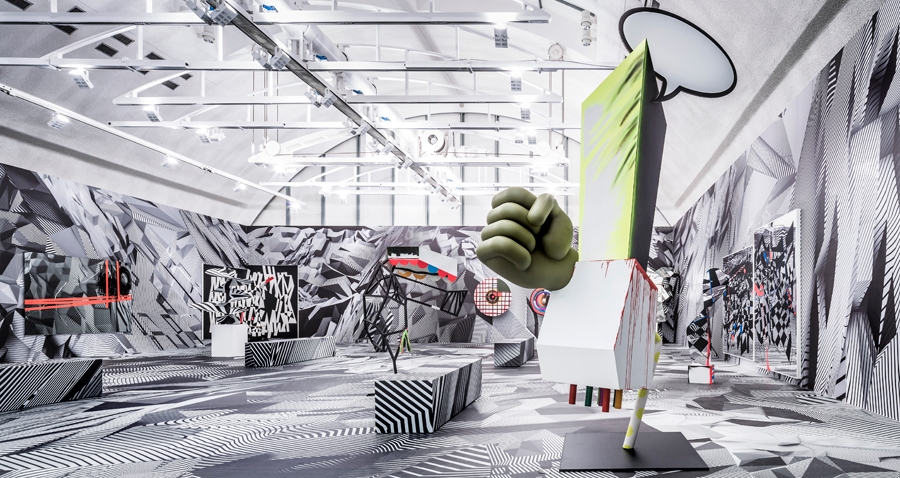This is an exhibition that demands close inspection. Even though the first thing Tobias Rehberger does is fuck up your eyes. Inspired by the dazzle painting that adorned Allied naval ships during the First World War, and that aimed to make it difficult for enemy vessels to calculate distance and movement when attempting to fire, the German artist – who studied and lives here in Frankfurt – has decorated the entire first room (walls and floor) with black-and-white geometrical patterns, and then placed within this hectic space a number of sculptures, some of which are similarly adorned. Mirrors, some cracked, complete the look. The blinding effects of all this razzle-dazzle presently become even more problematic for the unwary visitor, as the works in the rooms that follow have been installed within a series of ramps, steps and troughs – it’s as if the artist wants to trip you up. Just in case you don’t get the message from the works themselves, you’ll know by now that Rehberger is a master manipulator.
Just in case you don’t get the message from the works themselves, you’ll know by now that Rehberger is a master manipulator
Take the collection of vases he’s selected, to which various of his artist friends – among them Rirkrit Tiravanija, Jorge Pardo and Sharon Lockhart – have been invited to add flowers, albeit without any knowledge of the receptacle into which they are to be placed. (Rehberger contributes blooms too.) These are presented as portraits, titled simply with the ‘sitter’s’ name. The implication, presumably, is that the flowers tell us something about the character of the ‘sitters’ and that the vases tell us something about how Rehberger views his subjects.
You presume that there is some truth in these portraits, but what do a collection of white and dark violet lupins tell us about Olafur Eliasson? Other than his preferred colours, forms and scents? And yet people constantly communicate in this way. Someone who buys a Philippe Starck gnome stool wants to tell us that they have a fantastic (albeit childlike) sense of humour. Whether they have one or not.
On the one hand we learn that objects tell a story; on the other how that story can be screwed around with, how an object can become something that it is not
On the one hand we learn that objects tell a story; on the other how that story can be screwed around with, how an object can become something that it is not. See also the cacophony of metal tubing of more-or-less-functioning neon elements, suspended in the museum’s entry rotunda and casting a shadow (sometimes, depending on the light and your positioning) that spells out the work’s title, Regret (2014), on the white plinth below it. There’s an implication that people project themselves similarly.
Some sense of ‘personality’ is inescapably present in many of the objects in this show. There are sculptures that smoke, drip (water) or feature flickering neon tubes, and one equipped with empty speech bubbles (are we supposed to fill them in? you wonder) and a giant cartoon fist. Others seem simply to have wandered away from their obvious supports. Rehberger calls these ‘handicapped sculptures’, and an interest in the prosthetic, or how a form might be extended, transformed or improved, also runs through the show. Literally in the Prosthese series (2000), in which the artist has created prosthetic arms, legs, knees, fingers, etc (using his own bodily measurements), with each plastic extremity adapted to give it an alternative function – the right arm ends in a ring (for lifting weights?), the right middle-finger in a bulbous growth (for pushing buttons?). Or in the atomised aspects of Michael Jackson throughout the show: a cuckoo clock that emits one of Jackson’s trademark screams every 15 minutes (Cuckoo M.J. IV, 2012) and a timer in which measurements of minutes and hours are indicated by illuminated photographs of Jackson featuring the various looks he offered up during his career (M.J. Timer, 2010).
All this is a perfect reflection of the real world, in that it is geared to offer up an aesthetics and prosthetics for personality (the right clothes, the right phone; you could extend this to the projected personalities on Facebook and dating sites too). Not least in the final work of the exhibition, Gu Mo Ni Ma Da (2006), in which the artist Danh Vō (who studied under Rehberger) adapted sketches of the 11-metre-long yacht that his father built in order to enable his family to flee Vietnam in 1980, to provide the blueprints for a sculpture in the style of Rehberger. The boat, an angular mass that looks like it might manifest some kind of stealth technology, was built, but here it is presented as a photograph on the back wall. This is an essay in how objects express relationships – here that of father and son, student and teacher – but it’s a twisted reflection of those relationships, like in a funfair’s hall of mirrors, in which even the artist himself is in danger of being reduced to little more than a look. And it’s this sense of daring that makes Rehberger’s work stand out.
This article was first published in the May 2014 issue.
